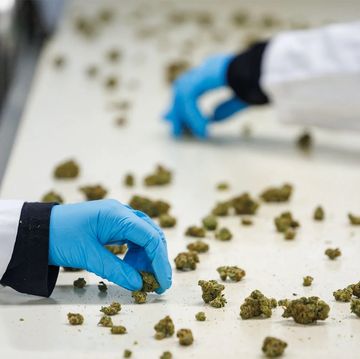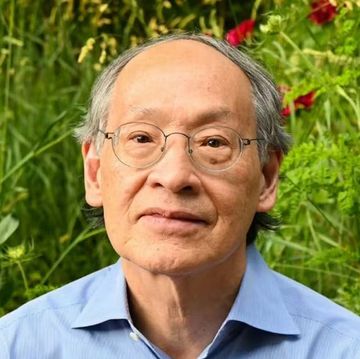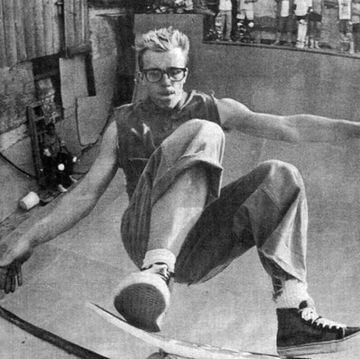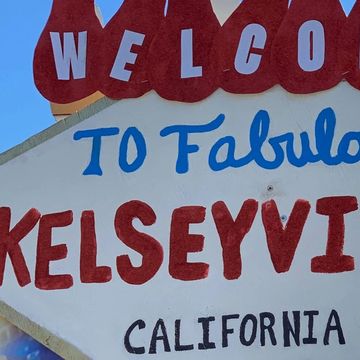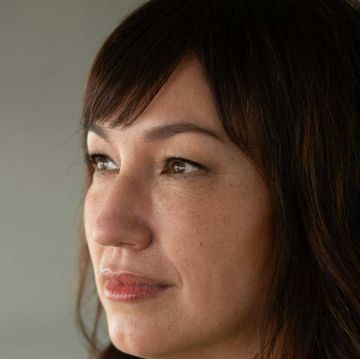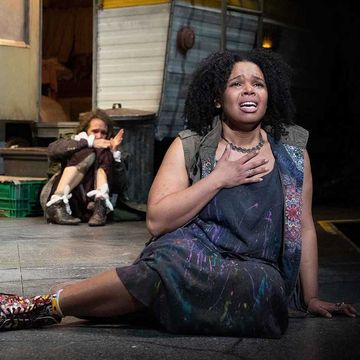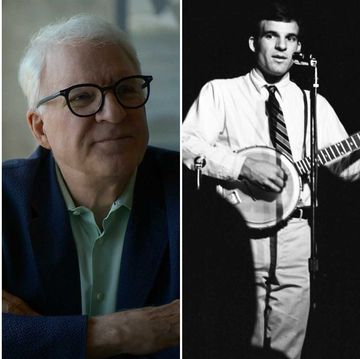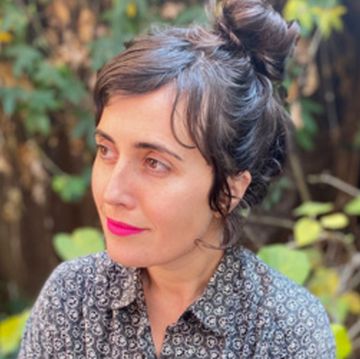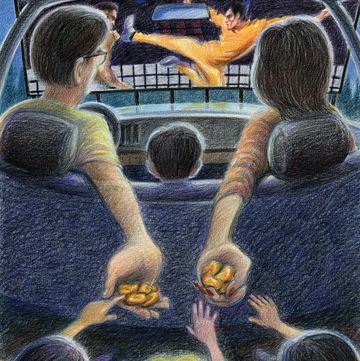“Knowing you has been the brightest part of an extremely bright twenty six years.”
—Jack
“I love him more than anything.”
—Inga
Inga Arvad and John F. Kennedy found each other at a cocktail party in Washington, D.C. “In a noisy place, I met a boy who was supposedly brilliant, and who laughed the whole time,” she later wrote him, referring to him in the third person, as she often did. “There is determination in his green Irish eyes.… When you talk to him or see him you always have the impression that his big white teeth are ready to bite off a huge chunk of life.”
It was the fall of 1941, long before Kennedy’s entry into politics. He was 24, fresh off the publication of Why England Slept, his bestselling book, and was serving as a naval ensign just before the bombing of Pearl Harbor. Suffering from a bad back and with his older brother first in line for a political career, he faced an uncertain path. Arvad was four years older and working as a newspaper columnist. A former Miss Denmark, she had already traveled the globe, had bewitched the world’s most powerful men, was married to a Hungarian filmmaker, and was suspected of spying for the Nazis.
This article was featured in Alta Journal's free Weekend Read newsletter.
SUBSCRIBE
In wartime Washington, Arvad and young Kennedy fell hard for each other. He introduced her to his friends and family, and they talked of marriage, raising children together, and moving out West. In Arvad, Kennedy perhaps found a refuge from his demanding family and their expectations of him.
“To you I need not pretend,” he once wrote her. “You know me too well.”
Yet a battery of forces—namely, his family and agents from the Washington intelligence community watching their every move—conspired to split them apart. As he rose in politics, Kennedy also lived with the fear that the release of confidential surveillance tapes from the FBI’s investigation, as well as a cache of documents and files, would hurt his career. It was those now-declassified files that I stumbled on, by sheer accident, that led me to this story.
Nearly a decade ago, while researching the files of former bureau head J. Edgar Hoover for a book on another FBI case, I discovered that Hoover had investigated Kennedy and Arvad’s relationship. He kept the resulting documents in his Official and Confidential files, the trove of sensitive information he often used to blackmail political foes and maintain power.
Fascinated by the romance, I also learned that after she’d split up with Kennedy, Arvad had quietly married a cowboy movie star and moved out West, where she raised two sons on a ranch. I tracked down one of her boys, Ronald McCoy, who was teaching at Oklahoma State University, in Stillwater. As a professor of history with a focus on Indian art, he’d collected his own stories over the years, but it was the account of Kennedy’s relationship with his mother that I was after—and the confession he remembered she’d made so long ago on the family ranch.
They called the ranch Los Arcos, or the Arches, figurative portals between so many of their worlds. With horses out back and scrubby desert for miles, McCoy was raised there in isolation, on the outskirts of Nogales, Arizona. He’d come home from college for the weekend, he recalled years ago, and was eating dinner with his mother. They were alone.
There’s something I want to talk to you about, Arvad said.
Since he was a kid, McCoy had listened to his mother’s stories, each one more dazzling than the last. And as her first child, with their common passion for history and politics, McCoy had become his mother’s confidant. She shared the most intimate details of her life with him, in conversations and letters, about her youth, her regrets, her looks.
But this conversation was different. The matter was so important that she didn’t want him to tell anyone, he later recounted. Not his younger brother, Terrence, and not his father, Tim.
It’s not a good thing to talk about because nobody would believe it, she went on. Even if they did, it’s not anyone’s business.
She had never imagined herself here. Of all the places she had lived—from Copenhagen, home of her birth, to Paris, to the Far East, New York, Hollywood, Washington D.C., and beyond—it was hard to imagine Arvad would settle down to raise her family in Nogales, a border town that straddles the southern flatlands and walnut orchards of Arizona and the factories and cattle ranches of northern Sonora, Mexico.
A pueblo port without water, Nogales is a crossroads with cheap labor on the Mexican side and a cottage industry of customs and border agents on the Arizona side to monitor its flow. The town offered none of what she treasured. But this is where she landed. Walking down Main Street in the late 1960s, speaking with a European accent that few could pinpoint—I imagine she cut a curious figure, the kind the West is known to attract: a personality with stories so bold and colorful, they must be running from something.
Arvad played the small-town part well. She did the typical things an Arizona ranch mom might: serving on the board of the local library, visiting the sick in the hospital. But unlike the moms who wore jeans and plaids and who might have saluted one another with a hee-haw “Howdy,” Arvad never stopped calling those she encountered “darling”—and with an attitude more befitting a Miss Europe contestant, which she had been.
“Baskets of flowers, buckets of champagne, and caviar” as well as “alligator bags from Dunhill and watches with emeralds and 22-carat [sic] gold” were all waiting in her hotel room, she wrote in her memoirs, when she arrived in Paris for the 1931 Miss Europe contest. There were other stories, of earlier times, but it was in Paris, during the competition, that young Arvad initiated a pattern that she’d repeat over and over again, a sequence that would eventually land her in the embrace of the future president and later in Nogales. It went like this: meet a stranger in a foreign place, share a fantastical moment, and keep the relationship going, no matter how unrealistic it seemed. In Paris, the fantastical moment came at a dance, with Kamal Abdel Nabi, an Egyptian diplomat.
“Miss Denmark, will you accept homage from an Egyptian?” he said in French.
How could she refuse? The following day, he placed a handkerchief upon her knee—a silk cloth emblazoned with the crest of his family—and proposed to her. Her answer was all instinct. Yes!
“Like extra flowers in a vase we moved from one extravaganza to the other,” Arvad later wrote. She was 17. Two years later, she moved back to Europe, never to return to Nabi or Egypt.
Back in Nogales, growing up on his family’s ranch, McCoy had a front-row seat to his mother’s stories. She sometimes worked on two manuscripts, one called “Truth” and the other called “Consequences,” that she never finished or published. She kept the manuscripts with letters, ideas for films, photographs, and even a movie poster with her name and picture on it—mementos from her other life, before the ranch. His mother had traveled to so many places around the globe and had clinked glasses with some of the world leaders named in his history books. Arvad’s life was like several novels twisted together, only it was all real.
There was the time she met Paul Fejos, a brilliant Hungarian movie director, doctor, pilot, opera composer, and explorer; journeyed to the Norwegian fjords to star in his silent film; and received a proposal from him via telegram (“ARRIVE TOMORROW: WILL YOU MARRY ME?”). She accepted and followed him to the Dutch East Indies to film and capture Komodo dragons for a zoo. There was the house on stilts that the newlyweds lived in, hovering over shark-infested waters, where she adopted a seven-year-old boy who smoked cigars and drank brandy. And the trip to Panang, a port in Malaysia, during which they met a Swedish vacuum cleaner king, who happened to be one of the world’s wealthiest men, who invited the couple back to his castle and to the Bahamas on his yacht (at the time, the biggest personal boat in the world) and went on to finance one of Fejos’s most ambitious expeditions: excavating a lost city in the Peruvian Andes.
The contents of Arvad’s steamer trunks and other luggage were those of an eclectic goddess: white evening gloves, a white silk evening gown, a black velvet evening cape, a black felt halo hat, a pair of smocks, a chess set, a dozen Chinese handkerchiefs, the works of Goethe, bottles of claret and port and apricot brandy.
But that was the adventurous life she shared with Fejos. Between trips with him, Arvad made a career for herself as a journalist. Never shy about speaking her mind or starting a conversation, she racked up a number of impressive scoops for a then-twentysomething reporter. In 1935, after a luncheon at the home of an ambassador, she broke the news of top Hitler lieutenant Hermann Göring’s engagement to Emmy Sonnemann, a German actress, having cold-called her. Sonnemann was so enthralled with Arvad that she invited her to Berlin to attend her wedding. Before the ceremony, Arvad stopped by Göring’s home.
“It looked like a museum,” she wrote. “Among the [wedding] presents I remember: a rare little bird in a gold cage sent from the emperor of Japan, quite a number of wild boars, a lion cub, emeralds as big as hen’s eggs—even a painting from Hitler.”
Mingling with the guests at Göring’s wedding, Arvad befriended and interviewed Joseph Goebbels, and the Nazis’ propaganda minister went on to arrange a pair of exclusive interviews with Hitler, who had declared himself führer a year earlier. Before passing into his antechamber, McCoy later recalled her telling him, she walked down several hallways and corridors and into an office lined with portraits, some with eyes that moved.
“Are you wearing a bulletproof vest?” she asked Hitler.
“Frisk me,” he said, which she did. (He was not.) They spoke for an hour and a half.
Hitler was positively entranced by Arvad. “A perfect Nordic beauty,” he called her. But for Arvad, her time with Hitler and the Nazis was only a momentary chapter. As the first concentration camps were built and Germany invaded her native Denmark and other Scandinavian countries, Arvad made her way to the United States (Fejos was still in the Peruvian Andes). She enrolled in journalism school at Columbia University and later landed a job at the Washington Times-Herald in Washington, D.C., writing a society column about the capital city’s elite.
One subject was John F. Kennedy. When he moved to Washington, it seemed inevitable that the United States would enter the war. Through his famous father’s connections, Kennedy landed a desk job at the Office of Naval Intelligence (ONI), far away from any future combat. His career path was fuzzy—focus on his writing or perhaps become a teacher. Having taken a road trip through Europe and audited business classes at Stanford, Kennedy was planning to help write the memoirs of his father, Joseph, who served as the ambassador to England under President Franklin D. Roosevelt and acted as a power broker inside the Democratic Party and the Irish Catholic community.
Upon arriving in Washington, Kennedy moved in with his sister, Kathleen “Kick” Kennedy. She was also working at the Times-Herald and had become close friends with Arvad, who lived nearby. They often walked to work together in the morning.
After Kick introduced her brother to Arvad and they started dating, Arvad became a momentary member of the Kennedy clan. Her husband, Fejos, was still far out of reach in South America, and when Kennedy wasn’t going to the ONI and Arvad wasn’t interviewing Washington’s establishment, she accompanied him to the golf course, watched him play touch football, met close friends of his like Torb Macdonald, and regularly joined him at Kick’s apartment for dinner. The menu was always the same.
“Soupe [sic], Steak, Mashed Potatoes, Peas, Carrots & Ice Cream,” Arvad wrote in one letter to Kennedy, fondly remembering those times.
After dinner, Kennedy and Arvad would routinely head back to her place. She’d rub his back with “Bingo oil,” he later recalled, whatever that was. Their dream was to escape the war and Washington and head out West, to lead a quiet life of writing and reading and family.
Yet Arvad also supported his passion for politics. While Kennedy’s oldest brother, Joseph, was first in line to run for the White House, Arvad encouraged Kennedy to forgo teaching and get into politics. “I can’t wait to see you on top of the world,” she once wrote him. “That is a very good reason why war should stop, so that it may give you a chance to show the world and yourself that here is a man of the future.”
As a couple, they faced three critical obstacles. One, Arvad was a nonpracticing Lutheran, not a Catholic like the religious Kennedys. Two, she was married. And three, in the minds of many at Hoover’s FBI and other intelligence agencies, she was a Nazi spy.
“You are mixed up in something,” Kennedy told Arvad, according to a transcript of one FBI wiretap from the winter of 1942.
“I wonder what it is,” she replied.
“It might have been something you said.”
“What could the conversation be about except you and me?” she asked him. “There’s nothing illegal they can put their hands on. What’s illegal about being in love?”
The origins of the FBI’s investigation into Arvad are redacted in documents. Once agents learned she was dating Kennedy, they dug into her past and documented how she had interviewed Hitler and written about him admiringly. They found that Fejos was indeed financed by a Swedish magnate, Axel Wenner-Gren, who the Allies believed was selling arms to the Nazis. In fact, Arvad was friendly with Wenner-Gren and his wife, Marguerite, and was receiving checks from Wenner-Gren’s company.
The obvious questions were raised: Was it possible Arvad was using the cover of being a journalist to interview top officials—in law enforcement and the military—and relying on the industrial tycoon to channel messages back to the Nazis? And had she started a relationship with a naval intelligence ensign from a politically powerful family to get inside information? At the White House, President Roosevelt sent a confidential memo to Hoover requesting heightened surveillance of Arvad. “In view of other certain circumstances that have been brought to my attention, I think it would be just as well to have her specially watched,” he wrote.
Their affair also placed Kennedy under suspicion. Since he was an officer in the navy, investigating him fell to the ONI rather than the FBI. Instead of discharging him, the navy transferred Kennedy to a base in Charleston, South Carolina, perhaps hoping that 500-plus miles between the two would keep him away from Arvad.
It did not. Besides eavesdropping on the couple’s phone calls, agents trailed Arvad as she traveled by train from Washington to South Carolina under a fake name (Barbara White) and checked in at a local hotel called the Fort Sumter. There, agents listened in on the pair’s conversations and activity. “It was learned that the subject and KENNEDY engaged in sexual intercourse on a number of occasions,” reads one FBI report, and “the subject was quite worried about becoming pregnant and spoke of the possibility of getting her marriage [to Fejos] annulled.”
After Arvad’s visits to Charleston, agents continued to listen in.
“I hear the hotel clerk at the Fort Sumter is an investigator,” Kennedy told Arvad, according to another FBI wiretap transcript.
“For what?” Arvad asked.
“The Navy,” Kennedy said.
“Wonderful!” she joked. “You’ll soon be kicked out.”
“There’s more truth than poetry to that,” he said.
According to Arvad’s files and FBI documents, her relationship with Kennedy imploded in March 1942. After spending more than a year in Peru, Fejos learned of Arvad’s affair, and they agreed to a divorce. Kennedy, however, was facing pressure from his family to break it off. He and Arvad agreed to end things. But shortly after, and with FBI agents listening, Kennedy appeared to have changed his mind.
“Surprised to hear from me?” he said during another wiretap.
“A little maybe,” Arvad said.
“Why didn’t you come?”
She had been planning to visit him again in Charleston but canceled her trip.
“What a question. Don’t you remember we talked about it on Sunday?”
“I know it,” Kennedy said.
“Oh, you don’t think it’s going to stay?”
“Life’s too short,” he said.
“Oh, Kennedy…I’m not coming. I don’t know. I’m not trying to be stubborn. I’m trying to help you out. You know that don’t you?”
“I figured it out,” Kennedy said.
“As far as I’m concerned, you don’t exist anymore,” she said.
After they split up, Kennedy was sent from Charleston to Chicago and later Melville, Rhode Island, where he learned to command the new line of PT boats, fast, agile motorboats armed with torpedoes. The navy hoped these speedy vessels could outmaneuver Japanese destroyers and sink them.
Arvad left Washington too. She had plans to return to New York to work for the Office of the Coordinator of Information—of all places, Roosevelt’s covert intelligence and propaganda unit, the precursor to the Office of Strategic Services, which later became the Central Intelligence Agency. Arvad never took the job, though, instead going to Los Angeles and taking over the legendary gossip column of Sheilah Graham, who sought reassignment after F. Scott Fitzgerald, her lover, died of a heart attack.
Promoted to lieutenant, Kennedy shipped out to the Solomon Islands, a desolate archipelago in the South Pacific, to command PT-109. Even there, he never gave up on trying to win Arvad back.
“Inga-Binga—what the hell is the story,” a lonely Kennedy wrote, using his pet name for her. “I write you a six page letter…plus a little blood when I cut myself trying to fix the typewriter and what do I get—nothing. Not even a rejection slip. What’s the idea?”
It was nearly a year after they’d split. Kennedy was still heartbroken. “Well, I suppose the war has brought us together…and it’s doing an excellent job separating us,” he wrote in another letter. “Lately, it appears permanently.”
Stationed in the Solomons, Kennedy kept her picture with him on his boat. He sent more letters her way in Los Angeles. “What exactly is your situation,” he wrote. “Are u settling down for a life of domesticity or do you remember a certain remark about dinner and breakfast when i get back.… Just give me the straight dope on that will you, so I know if this whole thing is worth fighting for.”
Arvad, however, had moved on. “A human breast to me has always been a little like a cage, where a bird sits behind,” she’d written him. “Some birds sing cheerfully, some mourn, others are envious and nasty. Mine always sang. It sang so loudly that I refused to listen to that other little sensible creature called reason. It took me the FBI, the U.S. Navy, nasty gossip, envy, hatred, and Big Joe [Kennedy’s father] before the bird stopped.”
“In the beginning, I was just stunned darling,” she wrote. “Then I slowly woke up.”
In the summer of 1943, Kennedy was nearly killed. The Amagiri, a Japanese destroyer, emerged from the darkness one night, barreling directly at Kennedy’s PT-109. It was moving so fast that he and his 13-person crew didn’t have time to launch the boat’s torpedoes.
“Everyone in the water,” Kennedy ordered as the Amagiri crashed through their hull, slicing the boat in half. Two of his sailors were killed instantly. Others were badly burned. The survivors clung to a remnant of the bow and drifted through shark-filled waters for 12 hours before swimming to a nearby island.
After several days without proper food or water, the men were aided by islanders who relayed a Mayday message that Kennedy had chiseled into a coconut. Kennedy and his crew were rescued.
“A number of illusions have been shattered, but you’re one I still have,” Kennedy wrote Arvad after the ordeal. When his PT boat had sunk, he’d lost the picture of her he’d been keeping. He asked her to send another. His outlook on life was changing.
“I used to have the feeling that no matter what happened I’d get through,” he wrote her. “I’ve lost that feeling lately, but as a matter of fact don’t feel badly about it. If anything happens to me I have the knowledge that if I lived to be a hundred, I could only have improved the quantity of my life, not the quality. This sounds gloomy as hell.… I’ll cut it.… You are the only person I’d say it [to] anyway, as a matter of fact knowing you has been the brightest part of an extremely bright twenty six years.”
The ghost of Kennedy lingered at the ranch in Nogales. A local historian recalled passing through Arvad’s bedroom at Los Arcos to use the bathroom and spotting an autographed picture of Kennedy on the wall. It read: “To dearest Inga Binga, love Jack.”
With his father often on the road doing Wild West shows or traveling with the circus, young McCoy became a witness to his mother’s memories of adventures and high-profile romances around the world. He was just like Kennedy, she told him. The way his mind worked, always compartmentalizing. The things he uttered. How he said them. His wit. And his passion for speechmaking and political instincts. In high school, he joined Boys State, a leadership program run by the American Legion, and then was selected for Boys Nation, one of the most competitive educational programs in the country, in which 100 high schoolers are picked from among 20,000 to travel to Washington to become mock senators. He continued on his path to politics at Arizona State University, running for student body president and winning.
A career in Washington seemed his destiny. When President Richard Nixon launched his reelection campaign, McCoy signed on. But much like Kennedy, McCoy was likely torn between his political inclinations and a desire to teach.
Then came his conversation with his mother—the secret she revealed during that weekend home from college, the one he couldn’t tell anyone.
I was pregnant when I married your father, she said, as he later recalled. She’d considered an abortion, but the opportunity had passed. She was already in her second trimester.
She’d been uncertain. She didn’t know who his real father was: Tim McCoy, the western actor she married and followed to Nogales, or Jack Kennedy, whom she told Ronald she’d always loved, had kept in touch with, and may have been seeing at the time he was conceived.
Arvad’s marriage to McCoy, on the surface, had never made a lot of sense.
When she’d announced their engagement, her friends had been confused. He was 22 years older than her, with children from a previous marriage, and they had little in common. If Inga Arvad was the European beauty queen and world traveler, Tim McCoy was the archetype of an American cowboy. A Hollywood star of westerns like Square Shooter and The Western Code, he rode horses and performed with Native American actors and learned their tribal languages; he could perform trick shots with pistols and bows and arrows.
Born in the early 1890s, McCoy had served in World War I and later earned the rank of brigadier general. Afterward, while living in Wyoming, he’d dabbled in politics and run for U.S. senator of Wyoming. He loathed the Kennedys and their elite brand of liberal politics, and couldn’t have been pleased about that autographed picture of Kennedy hanging on their bedroom wall.
Arvad and McCoy didn’t have a proper wedding. They married quietly on Valentine’s Day 1947 in upstate New York. He wanted to take his betrothed to Cartier to pick out a diamond band. She chose a $14 ring from Sears instead. She never thought it would last. Her relationships, she joked, never did.
Given how close they were, Ronald McCoy arguably has the most insight into his mother’s career as a journalist, her encounters with historical figures, and her take on her old relationship with Kennedy.
Shortly after seeing each other in Oklahoma about seven years ago, McCoy and I continued our conversation at his second home, in southern Florida. Before I arrived, he’d placed several boxes of his mother’s belongings on the living room floor. Over the next few days, I went through them all, reading postcards, taking pictures of old passport photos, flipping through the pages of memories, unfinished stories, so many letters, and other materials. Among these items, I discovered a file that contained the transcript of an interview McCoy had given in 1974.
“It blew my head right off,” McCoy says in the transcript, describing his reaction upon learning that his mother thought John F. Kennedy could be his dad.
When I asked him about it—during conversations on the patio before dinner and in the hot tub during interview breaks—he bristled and demurred. He didn’t want to talk about it.
McCoy’s recollections of his mother’s secret had created a brief rift between him and his brother and father. I found that the 1974 transcript matched an interview he gave authors Joan and Clay Blair Jr. for The Search for J.F.K., a Kennedy biography published in 1976, but which he later tried to downplay in a life story of Arvad by Scott Farris, from 2016. He tells the author that his mother’s confession about having Kennedy’s baby was an exercise in “wish fulfillment,” an attempt to believe past dreams in the sunset of her years.
I gave up on the story. Until recently. I was up late one night several months ago, and a long-overdue cleanse of hard drives led me to the cache of Arvad’s old letters and photos that McCoy had shared with me nearly a decade earlier. Going over the materials, I realized that, just as she had with all her other suitors, Arvad had cast her spell on me.
“Luscious is the word” is how the journalist John White described her. “Like a lot of icing on the cake.”
Moreover, I couldn’t help being seduced again by her little-known romance with Kennedy and all the unanswered questions about its ending.
I flew to Boston to visit the Kennedy presidential library and sift through the archives. Was it possible, I wondered, that Kennedy and Arvad had continued their love affair after he’d returned from the South Pacific? And more specifically, could they have been together in November 1946, the month Ronald McCoy was conceived?
They had seen each other after the war. I found a letter from Arvad to Kennedy dating from about a month before his return from the Solomon Islands. She asked for an exclusive interview, offering to pick him up once his ship had landed in San Francisco, then drifted into matters she called “horribly private.”
“I’m on pins and needles, because you’ll soon be home,” she wrote. “You do know—or don’t you—that you are the person in this world I would rather see than anybody—or is that a little too much of an admission?”
Arvad got another scoop. In a newspaper article dated January 11, 1944, around the time that Kennedy returned stateside, she interviewed him about the sinking and rescue of PT-109.
“None of that hero stuff,” Kennedy told her in the story, whose dateline was Los Angeles, where she was based. So they had seen each other after he’d come back. But what about nearly three years later, during the month of November in 1946?
The timing here is tricky. Throughout 1946, Kennedy was running for Congress and spending nearly all of his time in Boston, living out of a hotel room. In his archives, there’s the typical mélange of news clippings, event invitations he accepted, those he declined. I began poking around the files of David Powers, a Boston political operative whom Kennedy had tapped to help manage his campaign and who went on to become one of his closest advisers, and encountered an unusual document.
It was a large index card on which Powers had listed the women Kennedy seems to have dated before and after the 1946 election. In Boston, there was Ann McGillicuddy, a longtime girlfriend, and Elinor Dooley, his nurse, and Pamela Farrington, a model. In San Francisco, Nancy Burkett, an old flame from Stanford, and in Los Angeles, Peggy Cummings. In New York, there was Flo Pritchett, a model, and then there was Inga Arvad.
On the index card, Arvad’s entry was unique. Powers had apparently indicated her romance with Kennedy from 1941 to 1942 with the annotation “Wash D.C.” But also beside her name was “NY” and “1946.” So the card in theory seemed to confirm what McCoy had said: his mother and Kennedy had seen each other in 1946, in New York.
Looking more closely at the card, I noticed something else. Unlike with the other women’s entries, Powers had drawn a circle around the year 1946. Did Powers’s circled year mean something—that Kennedy was concerned Arvad was pregnant? Or did it mean nothing at all?
By 1946, Arvad had returned to the East Coast. She’d taken a job as a fashion editor at Harper’s Bazaar and was living in New York. She was 33, anxious to settle down, marry, and have children. In letters, she’d already started referring to herself as a spinster. With Kennedy on the campaign in Boston and Arvad in New York, I wondered, what events could have brought them together?
I scanned clippings from the local Boston and New York newspapers. Nothing. I checked the invitations Kennedy had received and accepted, digging through hundreds. Nada. Then I found his hotel receipts from more than 70 years ago.
Kennedy and his campaign had kept what appeared to be a decent accounting of his expenses. Among hundreds of sales slips filed away, I discovered a number of hotel bills from the Waldorf Astoria in New York, dating from November 1946.
Less than 48 hours after being elected a U.S. representative from Massachusetts, the receipts showed, Kennedy had checked into the Waldorf for what appeared to have been a celebratory weekend. He was accompanied by his longtime friend Torb Macdonald, whom Arvad had also befriended during the war years in Washington. According to his receipts, Kennedy stayed at the Waldorf through the weekend after his election, leaving on Sunday, November 10. He then checked back in the following weekend, receipts showed, and stayed at the hotel through November 18, 1946.
I tried to imagine it. After getting transferred from Washington, then surviving the PT-109 ordeal in the South Pacific, Kennedy had taken the first major step of his political career, winning his grandfather’s former Massachusetts congressional seat and keeping alive his father’s dream of getting a son in the White House. He was only 29, and after so much work, surely, in Kennedy fashion, it was time to cut loose.
On his hotel bills, Kennedy appeared to have paid for several pricey meals. Were any of those celebrations of some kind? And if he’d invited his old friend Macdonald to the hotel, might he not have extended an invite to Arvad, who had encouraged his entry into politics so many years before?
It’s nearly impossible to say what happened at the Waldorf as young Kennedy took his victory lap in Gotham. But the timelines, I thought, were curious. According to online databases, McCoy would have been conceived between November 15 and November 23, 1946, a period that covers Kennedy’s second weekend in New York. Could Arvad have been there, fulfilling the wish she’d shared with him before so many forces pushed them apart?
I reached back out to McCoy. He’s now in his 70s and retired from teaching. After so much time had passed, I was hoping he would tell me more about his mother’s extraordinary life and times, her romance with and confession about Kennedy, anything. He declined.
“It’s not personal at all,” he wrote me in an email. I went back to the cache of files, digging up those early childhood photos of him with the shock of reddish hair and the freckles, and those news clippings of him from his days in politics, dressed in dinner tuxedos, making speeches and writing editorials. Was I searching for my own form of wish fulfillment, fanning my desire to understand this story, or were these resemblances to the man his mother once remarked was hungry to take a chunk out of life?
After Kennedy was assassinated, Arvad disappeared into her room and cried and rarely spoke about him after. A decade later, she developed a fatal case of colon cancer, leaving perhaps the last clues of this mystery in the letters they shared.
“Could I do what I wanted today, without consideration to anybody, I think I would go out West,” Arvad wrote Kennedy during the height of their romance. “Before I left I would make sure that I had your baby along with me. You may say why mine? Well, not because I love you but because you are the kind the world ought to swarm with. You have just sufficient meanness in you to get along, and enough brains and goodness to give the world and not only take.”
A longtime investigative reporter, Geoffrey Gray is the author of Skyjack: The Hunt for D.B. Cooper, a New York Times bestseller, and the founder of True Mastery, the real-life adventure game. He wrote about the search for Forest Fenn’s treasure for Alta, Fall 2019, and consults Wanugee, a fortune-teller, also featured in this issue.

Geoffrey Gray is a New York Times bestselling author, longtime investigative reporter, and the current founder and publisher of True Mastery, which specializes in adventure tales and interactive, real-life games. Known for his eclectic range of subjects and gonzo spirit, Gray started his writing career covering boxing for the New York Times and later specialized in unsolved crime, travel, food writing, and more as a contributing editor at New York magazine. He has also produced two feature documentary films, Patrolman P. and GORED, the latter of which premiered at the Tribeca Film Festival and debuted on Netflix. He is the co-creator of 9 Arches, an adventure card game, lives (most of the time) in the colonial highlands outside Mexico City, and once drove an ice cream truck.




